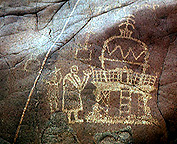
Chilas II, Karakorum Highway
Upper Indus River, Northern Areas of Pakistan
ca. 1st century C.E.
Copyright © Heidelberger Akademie der Wissenschaften, 1997
This petroglyph was abraded onto the face of a rock between the Karakorum Highway and the Indus River below the town of Chilas in the Northern Areas of Pakistan. A Kharosthi graffito written above the drawing records the name of Pushia, a resident of Oni (P[u]shiena onivastav[ena], with brackets indicating uncertain portions of the text). Since other Kharosthi inscriptions at Chilas II can be dated on the basis of paleography in a period from the late first century B.C.E. to the middle of the first century C.E., this Kharosthi graffito and petroglyph also probably belong to the same period. The rock drawing depicts two figures dressed in robes (presumably Buddhist monks) approaching a stupa in veneration. The larger figure with a shaven head is carrying an censer, which is identifiable by the smoke rising out of it. The stupa to which the offering of incense is being made consists of a rectangular foundation with a ladder leading up to the path for circumambulation, which is surrounded by a railing. The dome of the stupa is decorated with a zigzag line, probably representing a garland, and is surmounted by a harmika (a small rectangular shrine) and a chattravali (a vertical shaft with three horizontal discs).
This petroglyph was abraded onto the face of a rock between the Karakorum Highway and the Indus River below the town of Chilas in the Northern Areas of Pakistan. A Kharosthi graffito written above the drawing records the name of Pushia, a resident of Oni (P[u]shiena onivastav[ena], with brackets indicating uncertain portions of the text). Since other Kharosthi inscriptions at Chilas II can be dated on the basis of paleography in a period from the late first century B.C.E. to the middle of the first century C.E., this Kharosthi graffito and petroglyph also probably belong to the same period. The rock drawing depicts two figures dressed in robes (presumably Buddhist monks) approaching a stupa in veneration. The larger figure with a shaven head is carrying an censer, which is identifiable by the smoke rising out of it. The stupa to which the offering of incense is being made consists of a rectangular foundation with a ladder leading up to the path for circumambulation, which is surrounded by a railing. The dome of the stupa is decorated with a zigzag line, probably representing a garland, and is surmounted by a harmika (a small rectangular shrine) and a chattravali (a vertical shaft with three horizontal discs).
The architectural and stylistic features of this stupa drawing are similar to those of stupas found in the Swat Valley and other parts of ancient Gandhara in northwestern Pakistan and eastern Afghanistan. Above the human figure offering incense and to the left of the dome of the stupa is a drawing of a single pillar with a capital (apparently a wild goat or ibex, which is the most common animal in rock drawings in northern Pakistan) on a rectangular platform.
--Jason Neelis
For additional analysis of this Buddhist petroglyph and inscription at Chilas II, visit the German site Volker Thewalt Verlag, or consult the following sources:
Carter, Martha. Petroglyphs at Chilas II: Evidence for a Pre-iconic Phase of Buddhist Art in Gandhara. In: South Asian Archaeology 1991 (ed. A.J. Gail and G.J.R. Mevissen). Stuttgart: F. Steiner, 1993, pp. 349-366.
Dani, A.H. Chilas, the City of Nanga Parvat (Dyamar). Islamabad: 1983, pp. 107-110, no. 84.
Fussman, G. Les inscriptions Kharosthi de la plaine de Chilas. In: Antiquities of Northern Pakistan, vol. 1 (ed. K. Jettmar). Mainz: Phillip v. Zabern, 1989, p. 20, no. 11,1, pl. 22.
Jettmar, K. and V. Thewalt. Zwischen Gandhara und den Seidenstrassen. Mainz: Phillip v. Zabern, 1985, p. 17, photo 16.
For more images of petroglyphs, see: Heidelberger Akademie der Wissenschaften, Rock Carvings and Inscriptions along the Karakorum Highway